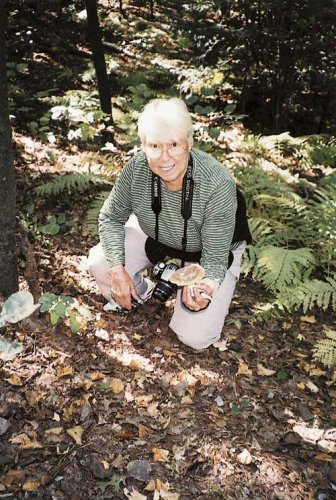Reta MacGregor of Goffstown was the guide when I went on a foray to hunt wild mushrooms at Livingston Park in Manchester. She has been studying and hunting wild mushrooms for more than 30 years. Her imagination was captured when she was given a book about mushrooms and she started hunting them in the wild.
There were about a dozen people on the field trip sponsored by the Osher Lifelong Learning Institute of Granite State College.
According to the National Audubon Society Field Guide to Mushrooms, “Mushrooms are among the most mysterious life forms.” In Greek mythology, mushrooms were said to come from Zeus’s lighting because they appeared after rain storms.
In Roman times, mushrooms were famous as a gourmet delicacy for royalty and were called the food of the gods, having supernatural powers. Recipes for their use have been found in ancient Greek and Roman writings.
The Caesar’s mushroom that is popular in Europe has some look alikes in North America that are poisonous. In describing the edibility of wild mushrooms, my books use the word “caution.”
Lacking chlorophyll, mushrooms must draw their nutrients from decaying organic matter or from living plants. Their role in the ecosystem is vital because they hasten the decomposition of dead plants and help provide living plants with water and minerals from the soil. Mushrooms reproduce by spores. In the extravagance of nature, thousands of spores can be produced by one mushroom.
The living organism that covers the largest area is not a gigantic sequoia tree or a great blue whale, but a mushroom. The mushrooms we see are only the spore-bearing fruiting bodies of the larger part of the plant that is underground.
In 1992, Myron Smith of the University of Toronto discovered a massive mushroom that covered 37 acres near the town of Crystal Falls, Mich. It was estimated at the time that the mushroom weighed more than 100 tons and was 1,500 years old. The discovery of the sprawling fungus with its vast subterranean network launched a media blitz that resulted in the town celebrating with a “Humongous Fungus Fest” each summer.
Now a huge mushroom has been discovered in the Malheur National Forest of eastern Oregon that is estimated to be 2,200 acres and is 3.5 miles across. The monstrous mushroom is thought to have been growing for at least 3,000 years. The mushrooms that appear above ground from this vast network under the soil’s surface are small and are called honey mushrooms.
In responding to everyone’s fascination with the humongous fungus, Smith said, “I like to think that what grabbed the imagination of the public was the idea that there are unseen things all around us that are magnificent.”
On our field trip, we found more than 50 different kinds of mushrooms, and MacGregor prepared a wild mushroom quiche she shared with us at lunch.









